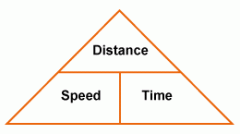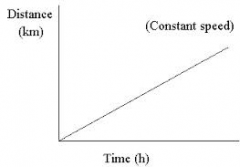![]()
![]()
![]()
Use LEFT and RIGHT arrow keys to navigate between flashcards;
Use UP and DOWN arrow keys to flip the card;
H to show hint;
A reads text to speech;
64 Cards in this Set
- Front
- Back
|
speed
|
distance divided by time
|
|
|
velocity
|
speed in a given direction
|
|
|
acceleration
|
change in velocity
|
|
|
How can you tell when an object is in motion?
|
It is changing distance from a stationary reference point.
|
|
|
What makes a good reference point?
|
a stationary object that is easy to see
|
|
|
Why is it important to know if your reference point is moving?
|
so you can tell if your object is moving or not
|
|
|
the periodic table has how many periods?
|
7
|
|
|
The periodic table has how many families or groups?
|
18
|
|
|
Describe in detail the modern model of the atom.
- particles - charge - location |
An atom has a central nucleus with protons and neutrons inside it and electrons orbiting outside it.
protons - positive and in nucleus neutrons - neutral and in nucleus electrons - negative and outside nucleus or in electron cloud |
|
|
What does the atomic number tell us about an atom?
|
The atomic number equals the number of protons.
The atomic number also equals the number of electrons. |
|
|
How does the reactivity (chemical property) of metals change as you move across the periodic table?
|
It decreases.
|
|
|
What property makes certain metalloids useful as "switches" to turn a small electric current on and off?
|
Their conductivity varies with temperature or other factors.
|
|
|
How are radioactive isotopes used to detect and/or treat different medical conditions?
|
They can be used to trace elements through your body so see how they are being used. They can kill certain cells.
|
|
|
What are three important things that need to be listed on each axis of a graph?
|
1. name of the variable
2. range of the values 3. units of the variable |
|
|
Describe the motion and arrangement of the particles in a solid, liquid, and gas.
|
solid - tightly packed, just vibrate
liquid - loosely packed, can flow gas - spread out and move freely |
|
|
state of matter with a definite shape and volume
|
solid
|
|
|
state of matter with a definite volume but no definite shape
|
liquid
|
|
|
state of matter without a definite shape or volume, can be compressed
|
gas
|
|
|
Explain what happens as a wet towel dries on a clothes line.
|
The sun warms up the particles of water in the towel causing them to vaporize, and the wind carries the water vapor away.
|
|
|
What is sublimation? What happens to the thermal energy and the movement of particles?
|
solid directly to a gas
energy gain and particle motion increases |
|
|
What is freezing? What happens to the thermal energy and the movement of particles?
|
liquid changes to solid
energy loss and particle motion decreases |
|
|
What is melting? What happens to the thermal energy and the movement of particles?
|
solid changes to a liquid
energy gain and particle motion increases |
|
|
What is condensation? What happens to the thermal energy and the movement of particles?
|
gas changes to a liquid
energy loss and particle motion decreases |
|
|
What is vaporization? What happens to the thermal energy and the movement of particles?
|
liquid changes to a gas
energy gain and particle motion increases |
|
|
How is the thermal energy of a substance related to its physical state?
|
As thermal energy increases, particles move more and the state changes from a solid to a liquid to a gas. As thermal energy is lost, particles move less and the state changes from a gas to a liquid, to a solid.
|
|
|
going from a liquid to a gas
|
vaporization
|
|
|
going from a gas to a liquid
|
condensation
|
|
|
going from a liquid to a solid
|
freezing
|
|
|
going from a solid to a liquid
|
melting
|
|
|
going directly from a solid to a gas
|
sublimation
|
|
|
What are three methods scientists use to study the natural world?
|
observing, inferring, predicting
|
|
|
What is the difference between a physical change and a chemical change?
|
If it alters the appearance of the matter without changing the type of matter it is a physical change. If it changes the type of matter and the properties, it is a chemical change.
|
|
|
Give three examples of physical changes.
|
cutting, melting, freezing, vaporization, dissolving
|
|
|
Give three examples of chemical changes.
|
burning, tarnishing, rusting, electrolysis of water
|
|
|
What is a qualitative observation? Give an example.
|
an opinion - The car was fast. The car was cool. The play was long. The cake was sweet.
|
|
|
What is a quantitative observation? Give an example.
|
a count or measurement (uses numbers) The car went 100 miles per hour. The play lasted 2 and 1/2 hours.
|
|
|
Explain the importance of using only one independent variable/manipulated variable at a time.
|
If you have more than one variable, you won't know which one caused the change.
|
|
|
How do you determine if a hypothesis is testable?
|
You must be able to make a prediction that you can observe and measure during an experiment.
|
|
|
Every physical or chemical change in matter includes a change in what?
|
energy
|
|
|
Describe the procedure for finding the volume of an irregular shaped solid.
|
water displacement - measure water - put the object in the water - see how much the volume of the water increased
|
|
|
What is density?
|
mass/volume
mass divided by volume |
|
|
What is volume?
|
the amount of space something takes up - 2 liter bottle - 3D measurement (length x width x height)
|
|
|
Is density a physical or chemical property? Why?
|
physical property - don't change the matter by measuring its mass and volume
|
|
|
What is malleability?
|
ability to hammer a metal out into a thin sheet
|
|
|
What is reactivity?
|
the ability of an atom to combine with other atoms to make compounds
|
|
|
What is ductility?
|
the ability of a metal to be drawn out into wires
|
|
|
What is distilling?
|
a way of separating mixtures by boiling point
|
|
|
What is filtering?
|
a way of separating mixtures by size of particle
|
|
|
What is evaporation?
|
vaporization from the surface of a liquid
|
|
|
What is decanting?
|
pouring a liquid off the top of a mixture without disturbing the solid at the bottom
|
|
|
What are three ways an object can accelerate?
|
1. speed up
2. decrease speed 3. change direction |
|
|
Draw the equation triangle for speed, time, and distance. Write the equation for speed.
|

Speed = distance/time
|
|
|
Write the equation for calculating time.
|
time = distance/speed
|
|
|
Write the equation for calculating distance.
|
distance = speed x time
|
|
|
Write the equation for calculating acceleration.
|
acceleration = change in velocity/change in time
|
|
|
Why is velocity more specific than speed?
|
It gives speed and direction.
|
|

Why is the above graph showing constant speed?
|
for every change in time, there is the same change in distance
|
|
|
If a car travels 30km in 20 minutes, you can find its what?
|
speed - distance over time
|
|
|
What has a greater speed, a heron that travels 600m in 60 seconds or a duck that travels 60m in 5 seconds? Show your work.
|
600/60 = 10 m/second
60/5 = 12m/second The duck travels 2m/second faster. |
|
|
Can an object have a constant speed and still be accelerating?
|
yes - It can change direction.
|
|
|
On a distance versus time graph, what does the slope tell you about the object's motion?
|
the velocity
|
|
|
A family takes a car trip. They travel for an hour at 60km/h and then for two hours at 40km/h. What is their average speed?
|
140 miles/3 hours = 46.7 mph
|
|
|
A car can accelerate from rest to 27m/s in 9 seconds. What is the car's acceleration?
|
27/9 = 3 meters per second/second
|
|
|
You own a truck delivery business and have a customer that needs to send an overnight shipment of materials to a work site in another city. The package MUST arrive by tomorrow morning at 8:00 AM. Both cities are in the same time zone and are 1000 miles apart. The maximum speed that your truck can drive is 75 mph, and the earliest you could leave is 3:00PM. Is it possible for you to make this trip and deliver the customer's order? You must factor in 3 hours for breaks and refueling.
|
total miles/total time minus 3 hours for breaks
1000 miles/17 hours - 3 hours 1000 miles/14 hours = 71.4 mph |

